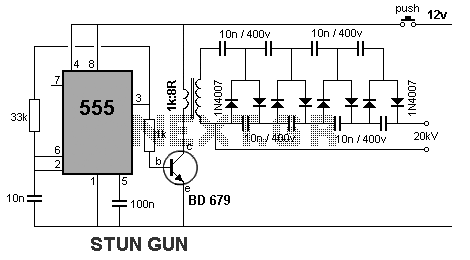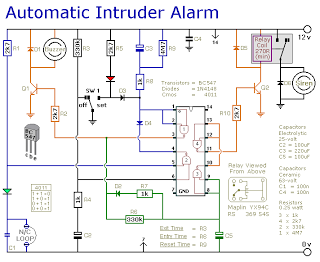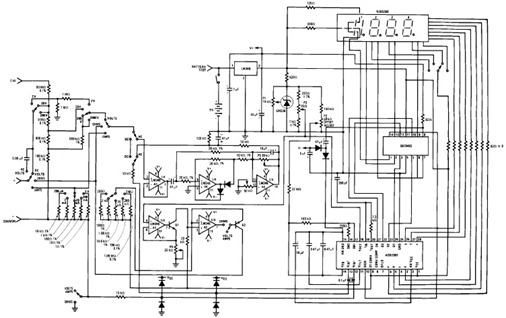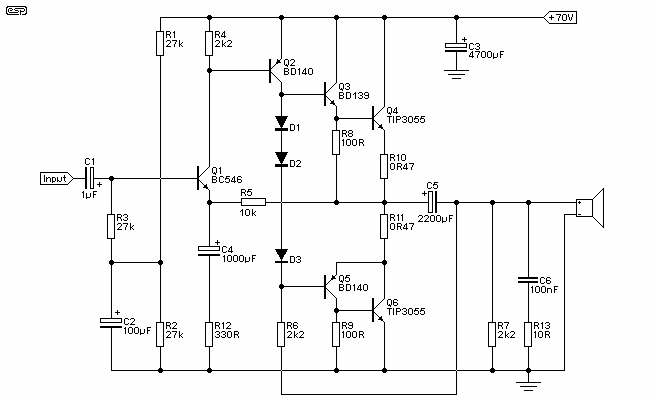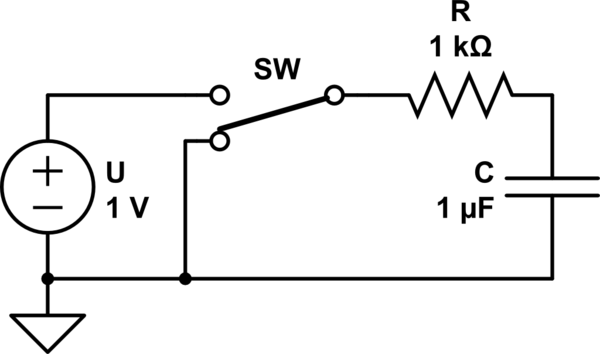
simple voltage doubler
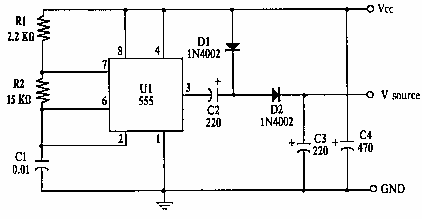
this circuit roughly doubles the voltage of the input, however the current output is low. doubled output is at V source. More: all resistors are 5 or 10 percent tolerance, 1/4-watt all capacitors are 10 percent tolerance. U1 NE555 timer IC R1 2.2k ohm resistor R2 15k ohm resistor C1 0.01 uF ceramic capacitor C2, C3 220 uF electrolytic capacitor C4 470 uF electrolytic capacitor
The described circuit utilizes a NE555 timer integrated circuit (IC) configured to function as a voltage doubler. The primary objective is to increase the input voltage, achieving an output that is approximately double the input voltage, although the output current is limited. The circuit's design incorporates several components with specific tolerances to ensure stable operation.
The NE555 timer (U1) is central to the circuit's functionality, operating in astable or monostable mode, depending on the connections of resistors and capacitors. In this application, it likely operates in astable mode to generate a square wave output, which is then processed to achieve voltage doubling.
Resistor R1 (2.2 kΩ) and resistor R2 (15 kΩ) are fundamental for setting the timing characteristics of the NE555 timer. The values of these resistors determine the frequency of the output waveform, which is critical for the effective operation of the voltage doubling mechanism. Both resistors have a tolerance of 5 to 10 percent and are rated for 1/4 watt, ensuring they can handle the power dissipation without overheating.
Capacitor C1 (0.01 µF ceramic) is used for stability and noise filtering in the circuit. It helps to smooth out any high-frequency noise that may be present, ensuring that the NE555 operates reliably. Capacitors C2 and C3 (220 µF electrolytic) serve as energy storage elements in the voltage doubling process, while capacitor C4 (470 µF electrolytic) provides additional smoothing of the output voltage, reducing ripple and enhancing the stability of the output voltage level.
The overall design of this circuit is straightforward yet effective for applications where a doubled voltage is required, albeit with the limitation of low output current. The choice of components and their respective tolerances is essential to maintain performance and reliability in various operating conditions.this circuit rougly doubles the voltage of the input, however the current output is low. doubled output is at `V source.` all resistors are 5 or 10 percent tolerance, 1/4-watt all capacitors are 10 percent tolerance. U1 NE555 timer IC R1 2.2k ohm resistor R2 15k ohm resistor C1 0.01 uF ceramic capacitor C2, C3 220 uF electrolytic capacitor C4 470 uF electrolytic capa 🔗 External reference
The described circuit utilizes a NE555 timer integrated circuit (IC) configured to function as a voltage doubler. The primary objective is to increase the input voltage, achieving an output that is approximately double the input voltage, although the output current is limited. The circuit's design incorporates several components with specific tolerances to ensure stable operation.
The NE555 timer (U1) is central to the circuit's functionality, operating in astable or monostable mode, depending on the connections of resistors and capacitors. In this application, it likely operates in astable mode to generate a square wave output, which is then processed to achieve voltage doubling.
Resistor R1 (2.2 kΩ) and resistor R2 (15 kΩ) are fundamental for setting the timing characteristics of the NE555 timer. The values of these resistors determine the frequency of the output waveform, which is critical for the effective operation of the voltage doubling mechanism. Both resistors have a tolerance of 5 to 10 percent and are rated for 1/4 watt, ensuring they can handle the power dissipation without overheating.
Capacitor C1 (0.01 µF ceramic) is used for stability and noise filtering in the circuit. It helps to smooth out any high-frequency noise that may be present, ensuring that the NE555 operates reliably. Capacitors C2 and C3 (220 µF electrolytic) serve as energy storage elements in the voltage doubling process, while capacitor C4 (470 µF electrolytic) provides additional smoothing of the output voltage, reducing ripple and enhancing the stability of the output voltage level.
The overall design of this circuit is straightforward yet effective for applications where a doubled voltage is required, albeit with the limitation of low output current. The choice of components and their respective tolerances is essential to maintain performance and reliability in various operating conditions.this circuit rougly doubles the voltage of the input, however the current output is low. doubled output is at `V source.` all resistors are 5 or 10 percent tolerance, 1/4-watt all capacitors are 10 percent tolerance. U1 NE555 timer IC R1 2.2k ohm resistor R2 15k ohm resistor C1 0.01 uF ceramic capacitor C2, C3 220 uF electrolytic capacitor C4 470 uF electrolytic capa 🔗 External reference
